| Basic Information | |
| What is this? | A region where stars are forming, which also includes the remnant of a massive star that exploded in a supernova |
| Where is it in the sky? | In the constellation of Aquila |
| How big is it? | The supernova remnant is about 100 light years across |
| How far away is it? | Around 10,000 light years |
| What do the colours represent? | The red, orange and purple regions are cold dust that is forming new stars. The blue region to the left of centre is very hot gas in the expanding bubble left by the supernova |
Downloads
See this object in:
Herschel has captured an image, along with ESA’s XMM-Newton x-ray satellite, of the shockwave left by an exploding star. The remnant of the supernova explosion, which goes by the name of “SNR W44”, comprises an expanding shell of warm dust and a bubble of extremely hot gas.
The dense network of filaments and clumps is part of a larger region of gas and dust, and stars are currently forming there today. As the supernova remnant expands it creating a shell of warm dust, seen as an asymmetric violet ring above, which passes through the surrounding region. As it interacts with the surrounding material, this expanding shell causes the gas and dust to be compressed, leading to fresh bouts of star-formation, as seen above-right of the shell in the image.
At the heart of the supernova remnant is what remains of the core of the exploded star itself. Only a few tens of kilometres across, but with roughly the same mass of the Sun, this is a rapidly spinning neutron star, called a pulsar. The extreme energy from this explosion has created a bubble of very hot gas, at temperatures of millions of degrees, which emits x-rays. This hot gas is picked up by the XMM-Newton x-ray satellite, and is seen to lie inside the shell of warm dust. XMM-Newton also sees the pulsar itself, as a tiny bright blue dot towards the top of the dark blue region. It is estimated that the pulsar, and therfore the remnant itself, is around 20,000 years old.
The supernova remnant is far from the obly object in the image. Clumps of warmer dust, which appears violet in this image, indicate the presence of stars in the process of forming. The hot, young stars heat up the dust and ionise the gas which surrounds them. The redder regions are much colder dust which is much more diffuse, and not yet forming stars, but is threaded by complex networks of filaments. The disk of material that makes up the plane of our Galaxy can be seen across the bottom left of the image.
Detailed Information
- “Life and Death in a star-forming cloud” – ESA Portal
- The curious shape of a supernova remnant in a star-forming cloud” – ESA Science & Technology




